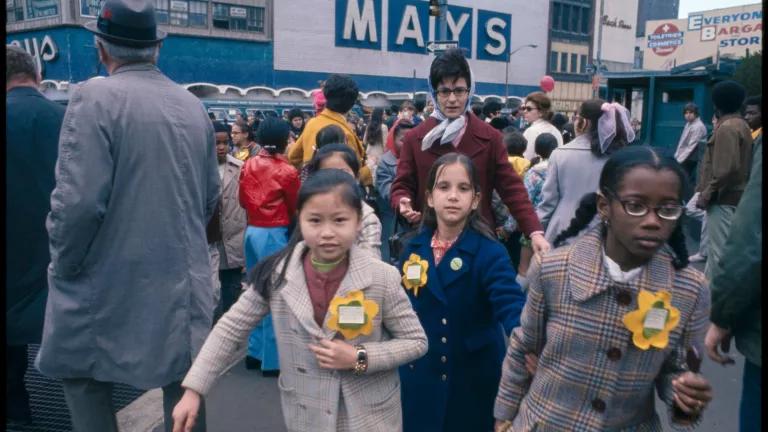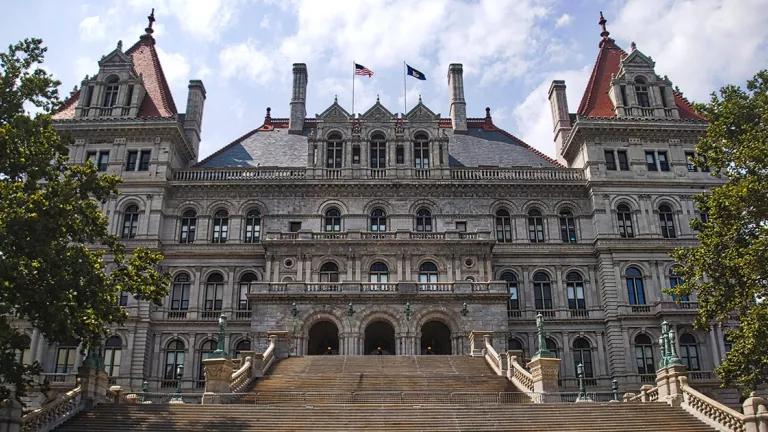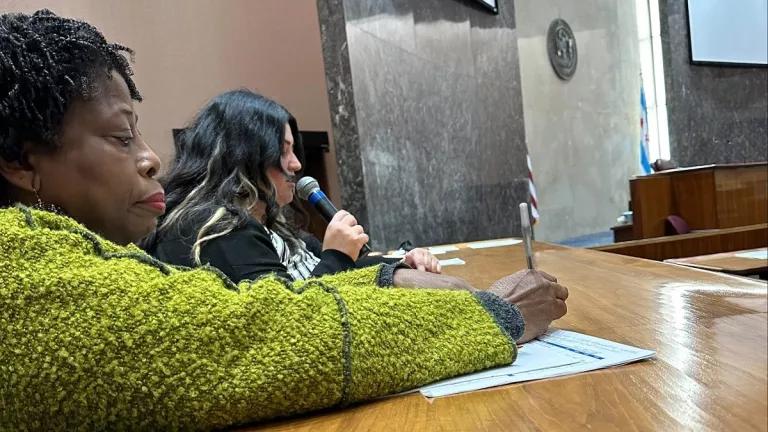Reflections on the First Earth Day and What’s Ahead for New York
On the 50th anniversary of Earth Day, NRDC's New York Political Director reflects on attending the first Earth Day event in New York City in 1970, and far the city has come thanks to New York's leadership on climate.

Earth Day 1: 1970—New York, NY
I was at the first Earth Day event in New York City nearly 50 years ago. Although April 22, 1970 fell on a Wednesday—and was clearly a school day—Union Square was teeming with young kids skipping class to demonstrate and demand protection for a world increasingly in peril.
The sequence of the day was something to behold. Con Ed, an Earth Day sponsor, had even loaned then-New York City Mayor John Lindsay an electric bus to shuttle back and forth between Union Square and the 42nd St. Library, the two main nodes of rallygoers. Lindsay and Kurt Vonnegut, a satirical 20th century writer known for his moral, often acerbic aphorisms, spoke at the library—I missed Vonnegut since I got pinned by surging crowds at Union Square, around 50 yards from George Washington’s statue. Later estimates claimed 100,000 people crammed into Union Square and it was sardine-can tight—the City had shut down 5th Avenue between and Central Park as well as 14th Street from 3rd to 7th Ave.
I had gone to celebrate Earth Day as part of a group of college kids from different schools, loosely organized by Sierra Club. Northwest of George Washington (and his horse) and within earshot, were a crew of eclectic individuals, one of which had brought along his pet parrot in a cage. The parrot didn’t say much though was mostly snarky, (somewhat like Vonnegut) when it did.
There were many disparate narratives folding into that first Earth Day, especially in New York City. Con Ed plugged for cleaner streets and put up clever Mad Men-like anti-littering ads on kiosks throughout the city. Hudson River fishermen were highly visible validators that day, speaking at both ends of the rally, appearing on the evening news and establishing a clean water trope for the day’s events. But it was New York City’s air quality, or its horrific degradation that rightly took center stage. It was the context and subtext, in a way, the subconscious drive behind most of the eco-zeal of that moment. You had to be there to believe it.
Soot on the Windowsill
Al Butzel, a veteran environmental lawyer of immense stature in New York, told the New York Times that you didn’t just breathe and see New York pollution, you could literally touch it too. Soot on the windowsill, a constant gray smog wrapped around the skyscrapers. The City in the ‘60s burned a third of its trash in 22 municipal incinerators and 2500 (!) incinerators in apartment buildings.
The filthy air proved to be fatal—the fastest growing cause of death in ‘60s New York was pulmonary emphysema, and chronic bronchitis became a common ailment. One surgeon told reporters that “if you lived in the Adirondacks, you had nice pink lungs. If you lived in the City, they might be blackened from pollution.” A particularly deadly weekend occurred on Thanksgiving in 1966 (in my early teens)—the city and state warned New Yorkers to stay inside. Around 200 deaths were later attributed to rank, foul air blanketing downstate New York that sobering holiday.
I had worked as a volunteer on Mayor Lindsay’s reelection campaign that past November, so I’d seen him speak often. He had a chilly affect, remote, a country club demeanor which never quite won the heart of bustling New York. But he gave a fiery speech that day, pointedly asking New Yorkers and Americans if they “wanted to live or die?” Throughout the speech, Lindsay placed pollution in the context of racism, poverty and unsound national priorities—emphasizing the (intersectionality) of society’s deepest failures, a reality that remains piercingly true today. The Mayor built a strong enviro track record—he had created the Environmental Protection Administration (later NYC DEP) in his first term. By his second term, Lindsay would win a nationally resonant clean air battle from Earth Day sponsor Con Ed, forcing them to burn low sulphur fuel at numerous plants.
After Earth Day, the environmental movement went on to secure a string of now familiar victories. Governor Nelson Rockefeller established the New York State Department of Environmental Conservation, still going strong after half a century. That December, Richard Nixon, presumably one of Lindsay’s main targets, signed the Clean Air Act into law and established the U.S. Environmental Protection Agency—two celebrated achievements that today are continually jeopardized by the Trump administration’s reckless and incessant disregard for environmental and public health.
New York’s Modern Legacy of Climate Leadership
In the decades since, New York State has emerged as a vanguard of environmental leadership (albeit it was not an easy road to stardom, but that’s for another day). The last incinerator in New York City was shut down over 20 years ago—a victorious battle for cleaner air and more just waste prevention strategies that NRDC helped wage.
Over the last nine years in particular, Governor Cuomo has been a central figure in intensifying New York’s climate action, securing sweeping nation-leading achievements, including the seminal 2014 Fracking Ban and 2019 Climate Leadership and Community Protection Act (CLCPA).
There are, of course, other impressive examples—from making New York the hub for offshore wind development to record funding for water infrastructure to the imminent closure of Indian Point nuclear power plant next week. Yet there is still much left to be done to organize our way toward a green economy and out of the climate crisis. In New York, that fundamentally begins with meeting the goals of the state’s new climate law, securing the $3 billion Environmental Bond Act that will create healthier, more resilient communities, tackling our transportation emergency head on through smart, regional policies that put people first.
As we’ve learned tragically in recent weeks, we can’t take anything for granted, and tomorrow is never promised. So, as we celebrate Earth Day and take stock of the past 50 years of advocacy, let’s be ready to fight like hell—against big polluters, naysayers, and politicians lining their pockets with fossil fuel cash—to ensure that for the next 50 years and 50 after that, our kids don’t have to fight quite so hard.




